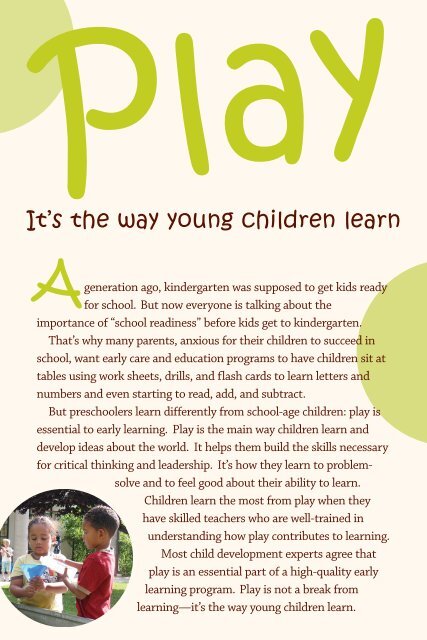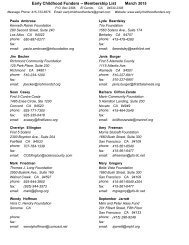Play: It's the Way Young Children Learn - Bay Area Early Childhood ...
Play: It's the Way Young Children Learn - Bay Area Early Childhood ...
Play: It's the Way Young Children Learn - Bay Area Early Childhood ...
- No tags were found...
Create successful ePaper yourself
Turn your PDF publications into a flip-book with our unique Google optimized e-Paper software.
<strong>Play</strong>It’s <strong>the</strong> way young children learnAgeneration ago, kindergarten was supposed to get kids readyfor school. But now everyone is talking about <strong>the</strong>importance of “school readiness” before kids get to kindergarten.That’s why many parents, anxious for <strong>the</strong>ir children to succeed inschool, want early care and education programs to have children sit attables using work sheets, drills, and flash cards to learn letters andnumbers and even starting to read, add, and subtract.But preschoolers learn differently from school-age children: play isessential to early learning. <strong>Play</strong> is <strong>the</strong> main way children learn anddevelop ideas about <strong>the</strong> world. It helps <strong>the</strong>m build <strong>the</strong> skills necessaryfor critical thinking and leadership. It’s how <strong>the</strong>y learn to problemsolveand to feel good about <strong>the</strong>ir ability to learn.<strong>Children</strong> learn <strong>the</strong> most from play when <strong>the</strong>yhave skilled teachers who are well-trained inunderstanding how play contributes to learning.Most child development experts agree thatplay is an essential part of a high-quality earlylearning program. <strong>Play</strong> is not a break fromlearning—it’s <strong>the</strong> way young children learn.
her own name! <strong>Children</strong> are more likely toremember skills and concepts <strong>the</strong>y have learnedby doing things that are meaningful to <strong>the</strong>m.▼ They learn from o<strong>the</strong>r children and developsocial skills by playing toge<strong>the</strong>r.When children play, <strong>the</strong>y learn skills thatcontribute to school successUsing one thing to represent ano<strong>the</strong>rThrough pretend play, children learn to use <strong>the</strong>ir imaginations to representobjects, people, and ideas.What you see:▼ A toddler flaps her arms, pretending to be a butterfly.▼ Ano<strong>the</strong>r picks up a banana, holds it to his ear like a telephone, and says,“Hello.”▼ A preschooler builds a firehouse with blocks.How it promotes school success:If children can use one thing to represent something else, it’s easier for<strong>the</strong>m to understand that letters represent sounds and numbers representquantities. And later on <strong>the</strong>y will be able to use <strong>the</strong>ir imaginations tovisualize historical events or scientific ideas.Using language and telling storiesThrough pretend play, children develop <strong>the</strong>ir skills in using language and intelling and understanding stories.What you see:▼ <strong>Children</strong> act out scenes in <strong>the</strong> housekeeping corner.▼ A child makes her stuffed animal “talk,” telling a story.How it promotes school success:Oral language skills and storytelling are <strong>the</strong> building blocks of reading andwriting, as well as subjects like social studies and science.
Using experimentation and logicWhen children play with materials such asblocks, clay, sand, and water, <strong>the</strong>y develop skills inlogic. They experiment with cause and effect, withcounting and sorting things, and with putting <strong>the</strong>min order. They learn how to invent strategies forsolving problems.What you see:▼ <strong>Children</strong> experiment with blocks to figure out how to build a stablestructure.▼ <strong>Children</strong> count <strong>the</strong> number of cups needed for a “tea party.”▼ <strong>Children</strong> pour sand into different sized containers.How it promotes school success:This practice in experimenting, observing, comparing, and working withshapes, sizes, and quantities forms <strong>the</strong> basis for understanding math andscience and for higher-order thinking.Developing self control and social skillsAs children share materials and play toge<strong>the</strong>r, <strong>the</strong>y learn to cooperate,listen to o<strong>the</strong>rs, stand up for <strong>the</strong>ir own ideas, handle frustration, andempathize.What you see:▼ <strong>Children</strong> negotiate over roles in dramatic play: “We can both be pilots ifwe have two seats.”▼ One child cries and ano<strong>the</strong>r says, “Don’t worry, your mom is comingsoon.”How it promotes school success:Many studies have shown that kids with good social skills and emotionalhealth do better in school and are more likely to avoid dangerous behavior asteenagers. Through play, children develop <strong>the</strong>ir ability to form relationshipswith o<strong>the</strong>r children and with teachers.
<strong>Learn</strong>ing to enjoy learningWhen children do activities <strong>the</strong>y havechosen, learning is enjoyable. It’s based on<strong>the</strong>ir own interests and gives <strong>the</strong>m a sense ofcompetence.What you see:▼ Classrooms organized with different activitycenters (blocks, dramatic play, painting anddrawing, reading, science, etc.).▼ <strong>Children</strong> encouraged to choose <strong>the</strong>ir own activities.How it promotes school success:Studies show that children’s attitudes of curiosity, motivation, andcompetence are key to success in elementary school.The teacher is key to play-based learning<strong>Children</strong> learn more through play when <strong>the</strong>y have well-trained teachers whoknow how to promote, respond to, guide, and extend <strong>the</strong>ir play to increaselearning—and how to assess <strong>the</strong>ir development by observing <strong>the</strong>ir play.Teachers can:Guide and extend play to help children learn more▼ Provide materials for unstructured play: Teachers put out collections ofobjects like cards or shells that children can arrange, sort, count or tellstories about. They provide “open-ended” materials like paper andcrayons or sand and water. <strong>Children</strong> combine materials from differentareas—a child brings a doll to <strong>the</strong> block area to build her a house.▼ Promote dramatic play: Teachers create areas of<strong>the</strong> classroom with props that encourageimagination, like pretend food anddress-up clo<strong>the</strong>s.
▼ Include outdoor play: Teachers create or bring children to outdoor playareas that include opportunities for physical play and experimentationwith natural materials such as water, dirt, leaves, and sand.▼ Respond to play: A teacher sees a child playing and builds vocabulary byproviding new words: “That’s interesting. You’ve lined up <strong>the</strong> animalsfrom tiny to gigantic.”▼ Extend play: A teacher hears children makingsilly rhymes: “You’re juicy, goosey, foosey.” Sheextends this play by teaching songs that playwith <strong>the</strong> sounds of language, such as“Apples and Bananas.” She knows that thishelps children learn to recognize <strong>the</strong>separate sounds in words.A teacher observes a child pretending a chairis a car and “driving.” She encourages imaginationby asking, “Where are you going? What do you see along<strong>the</strong> way?”▼ Guide play: One week a teacher turns <strong>the</strong> dress-up area into a shoe store.<strong>Children</strong> practice language and social skills by acting out “customers” and“sales people.” They learn new vocabulary (canvas, boots). They use art tomake signs for <strong>the</strong> store. Some older preschoolers may write letters andwords for <strong>the</strong> signs, or practice simple math by making change forpurchases.Assess children’s development by watching <strong>the</strong>m play▼ Observe <strong>the</strong> child’s activities: Seeing a child line up toy dinosaurs by sizeshows her understanding of size comparisons and putting things in order.▼ Listen to <strong>the</strong> child talk: Hearing a child talk about whatletters “say” shows his understanding that lettersrepresent words.▼ Take photos: A series of photos of a child’sblock structures over time shows that she islearning more about spatial relations.
Parents can:▼ Provide playthings that kids can use ina variety of ways: blocks, paper andcrayons, dolls and toy animals, balls,playdough, etc.▼ Encourage kids to play with ordinaryhousehold objects like pots and pans,utensils, spools of thread.▼ Take kids outdoors in all kinds of wea<strong>the</strong>r. Encourage <strong>the</strong>m to explorenatural materials like rocks, sticks, and mud. Provide simple playthingssuch as blocks and balls that encourage children to be active and use <strong>the</strong>irimaginations, not to watch while a toy does tricks.▼ Encourage imaginative play by providing simple props like a collection ofold hats or scarves. <strong>Play</strong> along when <strong>the</strong>y pretend: “Oh, you’re a lion?Are you a scary lion?”▼ <strong>Play</strong> with your children, ask <strong>the</strong>m questions about <strong>the</strong>ir play (“What arethose animals doing?”), and point out things you notice (“You used a lot ofbright colors in that picture!”).▼ Look for child care and preschool programs where children learnthrough play. Ask: How does this program use play to help children learn?Policy recommendationsBecause play is so important to developing <strong>the</strong> skills, concepts, andapproaches children will use throughout <strong>the</strong>ir lives, public policy shouldsupport early education that emphasizes play. Parents and child careproviders can urge policymakers to:▼ Adopt guidelines for preschool programs that emphasize <strong>the</strong> importanceof play.▼ Develop or choose curricula and learning materials that emphasize play.▼ Support in-depth training and ongoing education for early childhoodeducators, including elementary school teachers, about how to use play topromote learning.▼ Educate parents about <strong>the</strong> importance of play.
For more information, go to www.4children.org/ecf.htm or call 415-733-8576. To order more copies, or for this pamphlet in o<strong>the</strong>r languages(Spanish, Farsi, Chinese, Korean, Vietnamese), go to: www.4children.org/images/pdf/<strong>Play</strong>_brief_order_form.pdfFor more about play and learningOn <strong>the</strong> Internet▼ Alliance for <strong>Childhood</strong>: Time for <strong>Play</strong> Every Day: It’s Fun andFundamental, www.allianceforchildhood.net/projects/lay/pdf_files/play_fact_sheet.pdf and <strong>Play</strong>work and <strong>Play</strong>,www.allianceforchildhood.net/projects/play/ pdf_files/<strong>Play</strong>work.pdf▼ Child Care Exchange provides free downloads and low-cost publishedmaterials for teachers and parents, www.ccie.com/▼ Article on Reclaiming <strong>Play</strong> available at https://secure.ccie.com/catalog/product_info.php?products_id=5018044&search=&category=50▼ <strong>Childhood</strong>: A Time for <strong>Play</strong>, National Kindergarten Association,www.nkateach.org/NKA/ Research_files/<strong>Play</strong>Paper.pdf▼ A Child’s Work: The Importance of Fantasy <strong>Play</strong> (excerpt), www.communityplaythings.com/resources/articles/dramaticplay/childswork.html▼ The Importance of <strong>Play</strong> in Promoting Healthy Child Development and Maintaining Strong Parent-Child Bonds, American Academy of Pediatrics,http://pediatrics.aappublications.org/cgi/reprint/119/1/182▼ A Mandate for <strong>Play</strong>ful <strong>Learn</strong>ing in Preschool, www.mandateforplayfullearning.com▼ National Association for <strong>the</strong> Education of <strong>Young</strong> <strong>Children</strong> publishes <strong>Early</strong> Years are <strong>Learn</strong>ing Years,short articles for parents and child care providers, including many on “play and learning.” 800-424-2460, www.nacyc.org/ece/eyly▼ National Public Radio: Old-Fashioned <strong>Play</strong> Builds Serious Skills, Alix Spiegel,www.npr.org/templates/ story/story.php?storyId=19212514▼ Creative <strong>Play</strong> Makes for Kids in Control, Alix Spiegel, www.npr.org/templates/story/story.php?storyId=76838288▼ <strong>Play</strong> in <strong>the</strong> <strong>Early</strong> Years, Key to School Success, <strong>Bay</strong> <strong>Area</strong> <strong>Early</strong> <strong>Childhood</strong> Funders,www.4children.org/images/pdf/play07.pdf▼ Zero to Three has many publications on understanding and making <strong>the</strong> most of children’s play.202-638-1144, www.zerotothree.orgBooks (check your local library or bookstore or find new or used online)▼ A Child’s Work: The Importance of Fantasy <strong>Play</strong>, Vivian Gussin Paley, University of Chicago Press,2004▼ Einstein Never Used Flash Cards, Kathy Hirsh-Pasek, Roberta Michnick Golinkoff, Diane Eyer,Rodale Press, 2003▼ Outdoor <strong>Play</strong>: Teaching Strategies, Jane P. Perry, Teachers College Press, 2001▼ <strong>Play</strong> at <strong>the</strong> Center of <strong>the</strong> Curriculum, by Van Hoorn, Nourot, Scales, and Alward, 4th edition, 2007,Merrill/Prentice Hall▼ <strong>Play</strong>ing to Get Smart, Elizabeth Jones and Renatta Cooper, Teachers College Press, 2005▼ The Power of <strong>Play</strong>, David Elkind, Da Capo Press, 2007▼ Scholastic <strong>Learn</strong>ing Through <strong>Play</strong> series, including: Dramatic <strong>Play</strong>, Music and Movement, Art,Problem-Solving, Language, Cooking, Blocks, Science, Math, Literacy, and more. This series is outof print but many titles are available at Amazon.com▼ Spotlight on <strong>Young</strong> <strong>Children</strong> and <strong>Play</strong>, Derry Koralek, ed., NAEYC, 2004<strong>Play</strong>: <strong>It's</strong> <strong>the</strong> <strong>Way</strong> <strong>Young</strong> <strong>Children</strong> <strong>Learn</strong> is a specialsupplement to <strong>the</strong> <strong>Children</strong>'s Advocate newsmagazine,based on <strong>the</strong> policy brief, <strong>Play</strong> in <strong>the</strong> <strong>Early</strong> Years: Key to School Success,from <strong>the</strong> <strong>Bay</strong> <strong>Area</strong> <strong>Early</strong> <strong>Childhood</strong> Funders (a project of Community Initiatives).Funding provided by The San Francisco Foundation; United <strong>Way</strong> of <strong>the</strong> <strong>Bay</strong> <strong>Area</strong>; and <strong>the</strong>First 5 <strong>Children</strong> and Families Commissions in Alameda, Contra Costa, Monterey,Santa Clara, Solano, and Sonoma counties.



